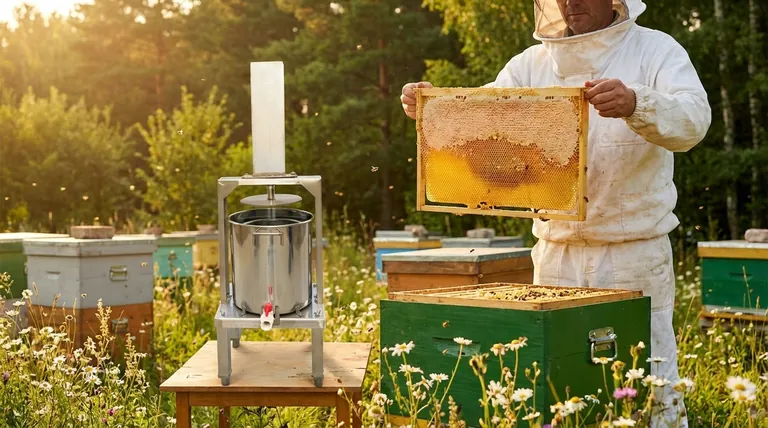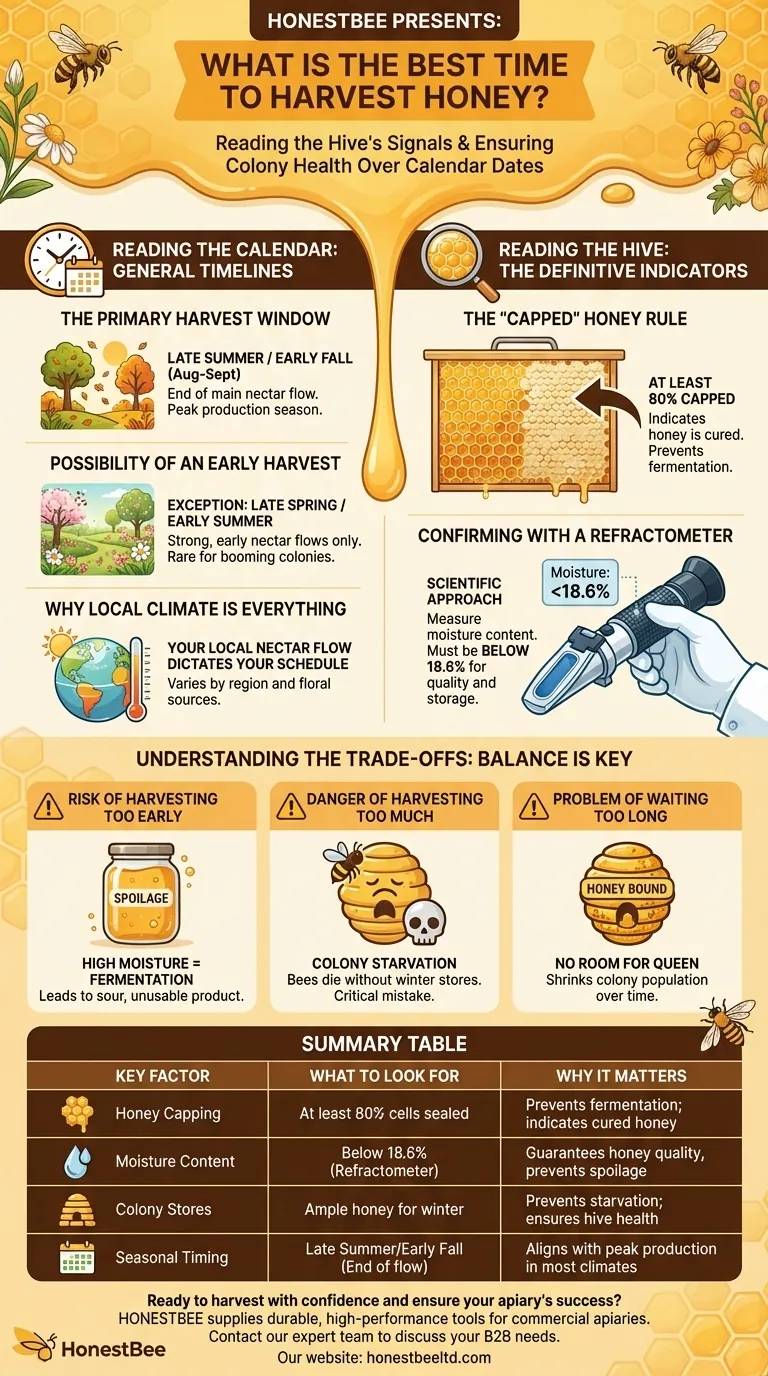The right time to harvest honey is less about a specific date and more about reading the signals from your hive and the environment. While most harvesting occurs in the late summer or early fall, the definitive answer is found by confirming the honey is cured and ensuring the colony has ample stores to survive the upcoming winter.
Successful honey harvesting is not a calendar event; it is a response to two critical conditions: the honey is "finished" (capped with low moisture) and the bees' winter survival is guaranteed.

Reading the Calendar: General Timelines
While hive inspection is the only true way to know, general timelines provide a useful framework for when you should start looking for harvesting signals.
The Primary Harvest Window
The most common time for honey extraction is at the end of the main nectar flow, which for many temperate climates falls in late summer or early fall (typically August and September). This timing allows bees to capitalize on the peak season of blooming flowers.
The Possibility of an Early Harvest
In regions with a very strong and early spring nectar flow, a secondary, smaller harvest may be possible in late spring or early summer. This is an exception, not the rule, and should only be considered in exceptionally productive years with booming colonies.
Why Local Climate is Everything
A beekeeper in a warm climate with year-round floral sources will have a completely different schedule than one in a colder region with a short summer. Your local nectar flow—the period when flowers are producing nectar—dictates your entire timeline.
Reading the Hive: The Definitive Indicators
A calendar gives you a hint, but the hive gives you the answer. Paying close attention to the state of the frames is the only way to harvest high-quality honey responsibly.
The "Capped" Honey Rule
When bees determine the honey has the correct moisture content, they seal the honeycomb cell with a fresh wax lid. This is known as "capping." This capping process cures the honey and prevents fermentation.
A frame is generally considered ready for harvest when at least 80% of the cells are capped. Harvesting honey that is not capped (often called "green" honey) is a primary cause of spoilage.
Confirming with a Refractometer
For a truly scientific approach, beekeepers use a tool called a refractometer. This device measures the exact moisture content of the honey.
To be graded as high-quality honey and to prevent fermentation in storage, the moisture content must be below approximately 18.6%. A refractometer removes all guesswork.
Understanding the Trade-offs
Harvesting honey is a balance. Taking it at the wrong time or taking too much can have significant consequences for both your honey quality and the health of your colony.
The Risk of Harvesting Too Early
If you harvest uncapped honey, its high moisture content will almost certainly lead to fermentation. This will spoil your entire harvest, resulting in a sour, unusable product.
The Danger of Harvesting Too Much
This is the most critical mistake a beekeeper can make. Bees create honey as their food source to survive the winter. Removing too much honey from the hive will cause the colony to starve and die during the cold months.
Always err on the side of caution. A living hive that produces honey next year is far more valuable than a few extra pounds of honey this year.
The Problem of Waiting Too Long
While less dangerous than harvesting too much, waiting too long can lead to a "honey bound" hive. This occurs when the bees fill every available cell with honey, leaving no room for the queen to lay eggs. This can shrink the colony's population over time.
How to Make the Right Harvest Decision
Your final choice depends on your goals and experience level. Use these principles as your guide.
- If your primary focus is colony health: Leave more honey than you think the bees will need for winter and only harvest from frames that are nearly 100% capped.
- If you live in a cold climate with harsh winters: Your number one priority is ensuring the bees have massive winter stores. Be extremely conservative and be prepared for years where you may not harvest at all.
- If you want the highest quality honey: Use a refractometer to confirm moisture levels are below 18.6% in addition to checking for capped cells.
Ultimately, your role is to act as a responsible steward of the hive.
Summary Table:
| Key Factor | What to Look For | Why It Matters |
|---|---|---|
| Honey Capping | At least 80% of cells sealed with wax | Prevents fermentation; indicates honey is cured |
| Moisture Content | Below 18.6% (measured with a refractometer) | Guarantees honey quality and prevents spoilage |
| Colony Stores | Ample honey left for winter survival | Prevents colony starvation; ensures hive health |
| Seasonal Timing | Late summer/early fall (end of nectar flow) | Aligns with peak honey production in most climates |
Ready to harvest with confidence and ensure your apiary's success?
At HONESTBEE, we supply commercial apiaries and beekeeping equipment distributors with the durable, high-performance tools needed for a perfect harvest—from refractometers to full extraction systems. Our wholesale-focused operations are designed to support your business's scale and efficiency.
Contact our expert team today to discuss your equipment needs and how we can help you maximize your honey yield while safeguarding your hives.
Visual Guide

Related Products
- 10L Stainless Steel Electric Honey Press Machine
- Stainless Steel Honey Press Wax Press with Tank
- Electric Flatting and Embossing Machine with Tray for Beekeeping
- Stainless Steel Manual Honey Press with Guard for Pressing Honey and Wax
- Professional Wide Blade Honey Scraper for Beekeeping and Honey Processing
People Also Ask
- What are the key features of the stainless steel honey press? Maximize Yield & Guarantee Purity
- What voltage options are available for stainless steel screw honey pumps? Choose the Right Power for Your Scale
- What are the main differences between centrifugal extractors and honey presses? A Guide for Commercial Apiaries
- What are the benefits of the screw design in a stainless steel honey pump? Preserve Honey Quality and Integrity
- What are the unique characteristics of honey presses? Maximize Honey Yield for Small-Scale Beekeeping



















